SQUARE AND SQUARE ROOTS PRACTICE QUESTIONS
Problem 1 :
The value of √144 + √1.44 is ?
a. 24 b. 13.2 c. 1.32 d. none of these
Solution :
√144 + √1.44
√144 = √12 x 12
= 12
√1.44 = √1.44 x (100/100)
= √(144/100)
= √(12 x 12) /(10 x 10)
= 12/10
= 1.2
√144 + √1.44 = 12 + 1.2
= 13.2
Problem 2 :
Which of the following triplet is a Pythagorean Triplet:
a. (4, 5, 6) b. (11, 60, 61) c. (10, 8, 6) d. both b and c
Solution :
Option a :
a = 4, b = 5 and c = 6
c2 = a2 + b2
62 = 42 + 52
36 = 16 + 25
36 ≠ 41
So, option a is not Pythagorean triple.
Option b :
a = 11, b = 60 and c = 61
c2 = a2 + b2
612 = 112 + 602
3721 = 121 + 3600
3721 = 3721
So, option b is Pythagorean triple.
Option c :
a = 10, b = 8 and c = 6
c2 = a2 + b2
102 = 82 + 62
100 = 64 + 36
100 = 100
So, option c is Pythagorean triple.
Hence the correct answer is option d.
Problem 3 :
How many non square numbers are there in between 𝑛2 𝑎𝑛𝑑 (𝑛 + 1)2
a. 2n b. 4n c. 3n d. 2n + 1
Solution :
There must be 2n natural numbers in between two consecutive numbers. So, the answer is option a.
Problem 4 :
The Simplified form of
is
a. 30 b. 3 c. 10 d. None
Solution :
So, the answer is 10.
Problem 5 :
Evaluate √52 + 122
Solution :
√52 + 122
= √25 + 144
= √169
Problem 6 :
2707/√x = 27.07, find x.
Solution :
2707/√x = 27.07, find x.
Multiply by √x.
2707/√x = 27.07
Divide by 27.07 on both sides.
2707/27.07 = √x
100 = √x
Squaring both sides.
(100)2 = x
x = 10000
So, the answer is 10000.
Problem 7 :
If √15625 = 125, then find the value of √156.25 + √1.5625
Solution :
√15625 = 125
= √156.25 + √1.5625
|
√156.25 = √(15625/100) = √(125 x 125) /(10 x 10) = 125/10 = 12.5 |
√1.5625 = √(15625/10000) = √(125 x 125) /(100 x 100) = 125/100 = 1.25 |
√156.25 + √1.5625 = 12.5 + 1.25
= 13.75
Problem 8 :
Find the square root of 14641 by prime factorisation method.
Solution :
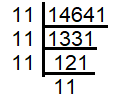
√14641 = √(11 x 11 x 11 x 11)
= 11 x 11
= 121
Problem 9 :
Find the square root of 144 by repeated subtraction method
Solution :
|
144 - 1 = 143 143 - 3 = 140 140 - 5 = 135 135 - 7 = 128 128 - 9 = 119 119 - 11 = 108 |
108 - 13 = 95 95 - 15 = 80 80 - 17 = 63 63 - 19 = 44 44 - 21 = 23 23 - 23 = 0 |
After 12 steps, we get 0. So, square root of 144 is 12.
Problem 10 :
Is 2352 a perfect square? If not, find the smallest multiple of 2352 which is a perfect square. Find the square root of the new number.
Solution :
Factoring 2352 :

√2352 = √(2 x 2 x 2 x 2 x 7 x 7 x 3)
After grouping them as pairs, we find one 3 as extra. To group it, we need one more 3. So, 3 is the smallest number to be multiplied to make 2352 as perfect square.
Problem 11 :
Find the least number which should be subtracted from 180 to make it a perfect square.
Solution :
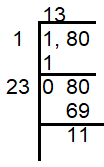
180 - 11 = 169
11 is the smallest number to be subtracted from 180 to make it as perfect square.
Problem 12 :
The length of a rectangle is 3 times its width. Its area is 972 sq. meter. Find the perimeter of the rectangle
Solution :
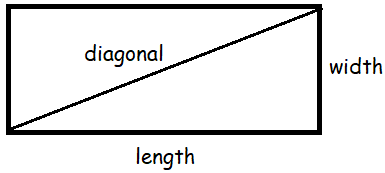
Let x be the width of the rectangle, then length will be 3x.
The diagonal will divide the rectangle into two identical triangles.
Area of triangle = area of rectangle / 2
= 972/2
= 486
(1/2) ⋅ 3x ⋅ x = 486
x2 = (486 ⋅ 2)/3
x2 = 324
x = √324
x = 18
3x = 3(18) ==> 54
Perimeter of rectangle = 2(length + width)
= 2(54 + 18)
= 2(72)
= 144 units.
Problem 13 :
A rectangle ABCD has AB = 12 cm and BC = 6 cm. Find the length of its diagonals correct to 2 decimal places.
Solution :
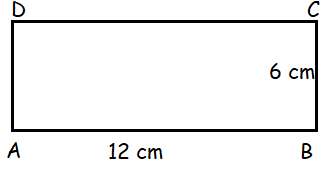
AC2 = AB2 + BC2
AC2 = 122 + 62
= 144 + 36
= 180
AC = √180
AC = 13.41
So, the length of the diagnal is 13.41 cm
Problem 14 :
Find the number of non-square numbers lying between 402 and 412.
a) 80 b) 40 c) 30 d) 84
Solution :
In between n2 and (n + 1)2, we will have 2n non square numbers.
When n = 40, n + 1 = 41
2n = 2(40)
= 80 non square numbers.
Problem 15 :
If m, n, p are natural numbers such that (m, n, p) forms a Pythagorean triplet if ?
a) m2 + n2 = p2 b) m2 + n2 < p2 d) m2 + n2 ≠ p
Solution :
(m, n, p) forms a Pythagorean triplet.
m2 + n2 = p2
Problem 16 :
The square of an even number is always____________.
a) even b) odd c) may be even or odd d) none
Solution :
- Let the even number as 4, its square = 42 ==> 16
- Let the even number as 6, its square = 62 ==> 36
So, square of even number is also an even number. Option a is correct.
Problem 17 :
The square root of 0.09 + 2 x 0.21 + 0.49 is
a) √0.09 + √0.49 b) 2 √0.21 c) 1 d) 0.58
Solution :
= √(0.09 + 2 x 0.21 + 0.49)
= √(0.3)2 + 2 x (0.3)(0.7) + (0.7)2
= √(0.3 + 0.7)2
= √12
= 1
So, option c is correct.
Problem 18 :
The digit in the unit’s place in the square root of 15876 is
a) 8 b) 6 c) 4 d) 2
Solution :
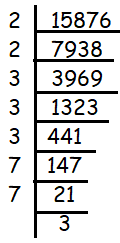
= √(2 x 2 x 3 x 3 x 3 x 7 x 7 x 3)
= 2 x 3 x 3 x 7
= 126
So, the unit digit is 6.
Recent Articles
-
Finding Range of Values Inequality Problems
May 21, 24 08:51 PM
Finding Range of Values Inequality Problems -
Solving Two Step Inequality Word Problems
May 21, 24 08:51 AM
Solving Two Step Inequality Word Problems -
Exponential Function Context and Data Modeling
May 20, 24 10:45 PM
Exponential Function Context and Data Modeling